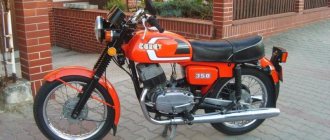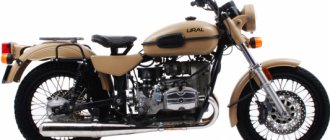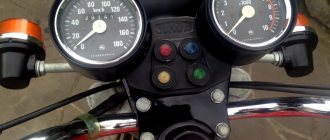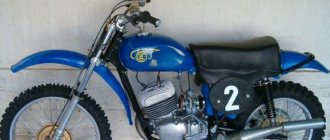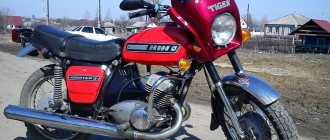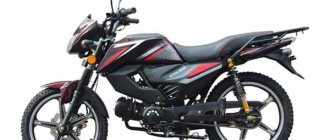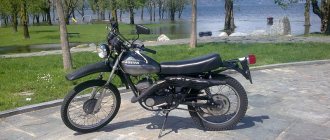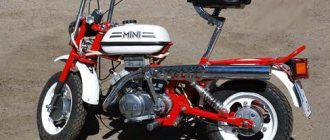Motorcycle technology was quite popular in the Soviet Union - motorbikes, mopeds and, of course, motorcycles.
Most young people chose motorcycles; they look stronger than mopeds and motorbikes, and they work more powerfully. In the USSR there were not many brands of motorcycles; all of them, without exception, were valued and loved by the citizens of the country. Foreign technology was especially popular and loved.
If we talk about motorcycles, the cherished dream of young people was a motorcycle made in Czechoslovakia - the CZ 350.
Cheset 350: technical characteristics
The main power plant is a two-stroke engine with 2 cylinders. The cylinder arrangement is in-line. The working volume is 343 cc. At the same time, the motor is capable of producing 22 hp. The Port control function was used as a distribution system. The engine receives the necessary cooling due to the oncoming air flow.
The transmission consists of 4 gears. The main transmission is a metal chain. Drum brakes are installed at the front and rear of the motorcycle. Front and rear wheel sizes respectively: 3.25-18 and 3.50-18. The fuel tank is designed for 18 liters of fuel. The motorcycle is capable of reaching a maximum speed of 125 km/h.
General information
In addition to the USSR, CZ motorcycles found their audience in other countries of the world, primarily due to their technical characteristics and success in motocross and enduro.
It was on Cesete that the Belgian racer Joël Robbert became the world champion, three times – 1964, 1968 and 1969. Also, the make and model of the motorcycle brought third place in the 1964 world championship to Soviet rider Viktor Arbekov. In 1695, he became the first Soviet world champion in motocross.
The history of CZ
The production of this motorcycle began in 1930 at the Česká zbrojovka plant in the Czech city of Strakonice. Previously, this plant produced weapons that had worldwide popularity, primarily due to the quality of work and service life.
The first motorcycle at the plant was created based on the prototype of the German model DKW NZ 350. The first motorcycle, the CZ 350, appeared in 1930, its main purpose was to ride on difficult terrain and rocks. The CZ 350 became the basis for the creation of more advanced motorcycle models. During the Great Patriotic War, the production of motorcycles at the plant was suspended, and the plant returned to the production of weapons.
But motorcycles produced in the pre-war period began to be actively used in combat operations - they delivered weapons, medicine, and food to the battlefield. According to statistics, out of 500,000 motorcycles involved in military operations, only about 200 were completely damaged. Even today, cars produced in Soviet times continue to fulfill their functional duties. After the end of hostilities, the production of motor vehicles within the walls of the plant resumed.
Motorcycle in the USSR
It is worth noting that the CZ 350 was not supplied en masse to the USSR, like, for example, its sister brand Jawa. This is probably why the CZ 350 had a special “foreign charm” and was highly valued among domestic motorcycle enthusiasts. In the USSR, the most popular were the 350 cc models of the 472 family, which were produced in various modifications from 1976 to 1989.
Unlike Java motorcycles, the CZ-350 was sold exclusively as “single” motorcycles, which further contributed to their popularity among young people. In the second half of the 80s, a new Chezet in a wooden box costs 1050 Soviet rubles.
The demand for Chesets was so high that in search of a new motorcycle, motorcyclists could travel halfway across the country to find their Chesets in some motorcycle or sports store. Today, such rarities can be sold for 1,500 euros, primarily due to the fact that in the Soviet years they were practically not used, they were taken more to show off, rarely when the mileage exceeded 2,000 kilometers.
IZH, Java or Chezet - which Soviet-era motorcycle is better now?
Soviet motorcycles were not all exclusively Soviet, although all these Javas and Chesets can rightfully be called Soviet, because more than 90 percent of these Czech motorcycles were supplied to the USSR.
Let's compare the Izh Jupiter-5, Chezet-350 and Java-638 motorcycles today. Which of these motorcycles is initially better, and which of these motorcycles is better currently.
Let's start with the Izh Jupiter-5 motorcycle. This model was produced until 2008, so there will obviously be more spare parts for Izh than for Java and Chezet. Externally, Izh Jupiter-5 looks quite classic, however, like the other motorcycles with which we will compare this motorcycle.
But the build quality of the Izh Jupiter-5 motorcycle is frankly lame when compared with Java and Chezet. And the reliability of Izh Jupiter-5 is much lower than that of Czech motorcycles.
The maximum speed of the Izh Jupiter-5 is 125 km/h, but it is almost impossible to ride a motorcycle at such a speed - you had to literally lie down on the tank, and in general, the piston system of the Izh Jupiter-5 could not tolerate riding at maximum speed - it quickly failed.
Izh Jupiter-5 starts up much better than its closest relative, Izh Planeta-5. If Planet’s kickstarter kicked very noticeably, I hit my foot and ankle, if I don’t remove my leg in time, then Izh Jupiter-5 can be started without getting off the motorcycle.
In general, if you look at the specific advantages of Izh Jupiter-5, then the motorcycle is stronger and more durable than Java and Chezet, it is more suitable for use in rural areas. But in technical terms, Izh is more capricious; its owner must be very friendly with hardware.
In general, if we are to speak essentially, then for rural areas it is not Jupiter that is better suited, but Planet-5. But since it would not be very appropriate to compare the single-cylinder Planet with the Java-638 and Chezet-350, which, as you know, have two cylinders, we are comparing the two-cylinder Jupiter-5.
Now let's move on to the Chezet-350 motorcycle. This motorcycle was valued much more in the USSR than the Izh Jupiter-5. If Izh was always on sale, then Cheset still had to be looked for, although finding Cheset was still quite easy - not just one store, but another store had such a motorcycle for sale.
Although the Chezet engine is only one horsepower more powerful than the Izh Jupiter-5 engine, the difference in dynamics between these two motorcycles is felt. Compared to Jupiter, Cheset really takes off; Jupiter-5, compared to Cheset, is more phlegmatic. Yes, by the way, the sound of the Chezet motorcycle engine at idle is much quieter than the sound of the Izh Jupiter-5 engine.
On good roads it is more comfortable to travel on the Chezet-350 than on the Izh Jupiter-5, the gearbox of the Czech motorcycle works much more clearly, gears are switched without any effort.
Well, Java-638. This is a legendary motorcycle of the Soviet era. The first difference between the Java-638 and the Chezet 350 is the engine. Many people claim that Cheset has a Java engine, and this is true, only the Java-638 has a new engine, it is more powerful, 26 hp. versus 23 hp at Cheset. Such an engine was installed on the Java-634.
Oddly enough, the Chezet engine, which is older in design, is more reliable than the Java-638 engine. Chezet's cylinders are entirely cast iron, while Java 638's have cast iron only the liners, and the cylinder ribs themselves are aluminum.
At the same time, Java-638, when starting from a standstill, lags slightly behind Chezet, although then it catches up with him, and the maximum speed of Java-638 is actually higher. This is due to the fact that Chezet is easier than Java. The Java-638 has a thicker frame and steel wheel rims, while the Chezet-350 has aluminum wheel rims.
It was for this reason that in the USSR Cheset was considered a more sporty motorcycle, because they usually didn’t race Soviet motorcycles at maximum speed, but starting from a standstill, who was faster - this happened all the time!
Well, what is better to buy now? Buy a Japanese motorcycle, I mean it, especially if you plan to ride a motorcycle often. Soviet and Czech technology from the USSR era is very old and problematic.
If you really want to buy an old Izh, Chezet or Java, I would recommend an Izh or Java; you won’t find original spare parts for Chezet these days. And collective farming there is all the way from Java - so it won’t be Chezet anymore!
Personally, I like Izh Jupiter-5 more than Java-638, apparently because I had a completed Java-638 in 2000, and had a lot of trouble with it!
Source
Decline of the CZ era
Unfortunately, the events of the nineties that took place in the USSR led not only to the collapse of the former union state, but also the entire Soviet bloc. The situation at the Ceska Zbrojovka plant turned out to be simply catastrophic. Showing increased interest in the products of the Czech manufacturer, the Italian concern Cagiva acquired the CZ plant and launched the production of Roadster motorcycles sold under the Cagiva brand. The new motorcycle was produced with two engine options - two-stroke Cagiva (V=124 cm3) and four-stroke CZ (V=200 cm3). However, the project turned out to be unprofitable and, in the end, it was decided to abandon the production of motorcycle equipment at the production facilities of the CZ enterprise. And yet, the Cheset motorcycle not only played a prominent role in the history of European and world motorcycle construction, but also became a world-famous brand, a kind of calling card of Czech masters from the city of Strakonice. Although, perhaps, everything is still ahead for him?..
Main differences from previous models
- Spacious fuel tank.
- Upgraded telescopic forks at the front (with black boots).
- Installed safety bars.
- Improved seat.
- Large headlight.
Models type 472.3 and 472.4 were equipped with small-volume gas tanks, which caused a lot of outrage among buyers. These tanks were suitable for sports motorcycles, but not for touring ones. From an ergonomic point of view, the shape of the tank was also unsuitable. The rear part of the tank was wide and caused inconvenience to the owner of the equipment in operation. The upgraded gas tank is designed for 18 liters of gasoline. Its shape has been changed, making travel more comfortable. Regardless of the driver’s configuration, sitting on the motorcycle does not cause discomfort.
Don’t forget about the telescopic fork at the front, which has undergone some changes. The lower pipes are made of light alloy, which in turn only had a positive effect on the price of the fork. Regardless of the operating conditions of the motorcycle, the fork works well both on small uneven surfaces and deep holes, bumps and potholes. In addition, travel has become safer. The fact is that it is very difficult to bring the fork to the bottom, dead-end position. Well, let us remind you about the new rubber covers on the fork, which prevent dust from getting into the middle of the fork. Due to this, the fork will serve for many years.
Modern edition
The modern production of CheZet motorcycles is very diverse. You can purchase a sports or classic type of motorcycle.
These models are produced for driving: amateur and professional.
These motorcycles are made using motors that have increased power and torque. Light weight. You can create fast dynamics during acceleration.
The classic version of CheZet motorcycles is considered to be a model with an engine capacity of 350 cm3. In terms of technical characteristics, these motorcycles are similar to Java motorcycles.
Therefore, many parts of these two brands of motorcycles are interchangeable. In 1973, these 2 companies merged to jointly release.
The most popular and best-selling model of the CheZet motorcycle is the CZ (CheZet) 350 12v.
This model belongs to the tourist class. 23 hp motor. With. A 4-speed gearbox is used. The engine speed is squeezed to the maximum - 5000 rpm.
The equipped motorcycle weighs 155 kg. The gas tank is designed for 13 liters.
In order to participate in off-road racing, another type of CheZet was developed: the 550.
This model is used for off-road driving and can accelerate quickly.
Purchased by racers who have been participating in such races for a long time.
Beginners who have recently mastered the CheZet touring model are not able to operate such a model.
This motorcycle has 40 hp. It uses a 6-speed gearbox to control the engine's maximum speed.
It can accelerate quickly and does not require special skills to handle. Consumes up to 6 liters of gasoline per 100 km of driving.
The Yamaha JOG RR sports scooter often becomes a winner in races; it will appeal to those who want to get the most out of their equipment.
Kawasaki Versys 650 technical characteristics of a Japanese bike, enduro class.
